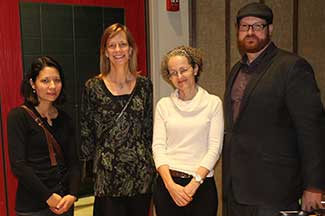Ancient Head Shaping Practices of the Maya
by Sahil Gadhavi
Dr. Vera Tiesler is a renowned authority on the life of Maya. She has been studying Mayans and their cultural practices through the use of bioarchaeology since very early in her career. Dr. Tiesler is a faculty at the Universidad Autonoma de Yucatan in the anthropology department and studies mortuary archaeology. When she came to give a talk at the University of West Georgia for the Department of Anthropology’s annual Waring Distinguished Lecturer Series, Cashen Hall was occupied on both levels, a rare occurrence.
 It is her interest in the field of bioarchaeology that has led her to gather so much insight into the practices of the ancient Maya who haven’t been seen for hundreds of years and whose decline still remains shrouded in mystery. In this particular talk she shed light on the ancient tradition of head shaping among the Maya that can be seen ever so prevalent in their architecture and art.
It is her interest in the field of bioarchaeology that has led her to gather so much insight into the practices of the ancient Maya who haven’t been seen for hundreds of years and whose decline still remains shrouded in mystery. In this particular talk she shed light on the ancient tradition of head shaping among the Maya that can be seen ever so prevalent in their architecture and art.
The Mayans are known for having shaped their heads by tying tight ropes around them to varying degrees depending on their social status or ethnicity. Head shaping, similar to the foot binding of the ancient Chinese, began at a young age regardless of gender. It was a way for them to honor their gods and deities whom they represented as having elongated heads.
The Mayans passed down the tradition of head-shaping from generation to generation starting in the classic period in 250 AD, through the post-classic period starting in 900 AD, all the way to the Conquista period starting in 1519 AD. The practice was only abolished when the Spaniards started bringing them into the Catholicism fold and outlawed the shaping of heads because they found it inhumane.
Today we can tell what sort of social structure they had based on the differences in their head shapes as they signify ethnicity, gender, status, and power of the individual being studied. Dr. Tiesler has made it her passion to go deeper into the mysteries of the Maya using all archaeological tools she has at her disposal. From their ornaments and social customs to their body modifications, nothing is a mystery unsolvable in the field of archaeology.
“What an interesting way to define social class through head shaping,” said Cassidy Rayburn, an anthropology major. “I have always seen pictures of Mayan art with people having elongated heads, and now I know why. Fascinating speech!”
Do you have a comment or opinion about this story's topic? Perspective Online wants to hear from you. Submit a letter to the editor today.
